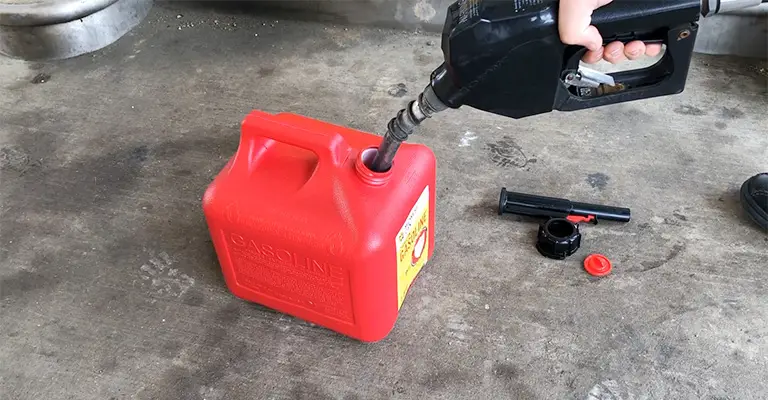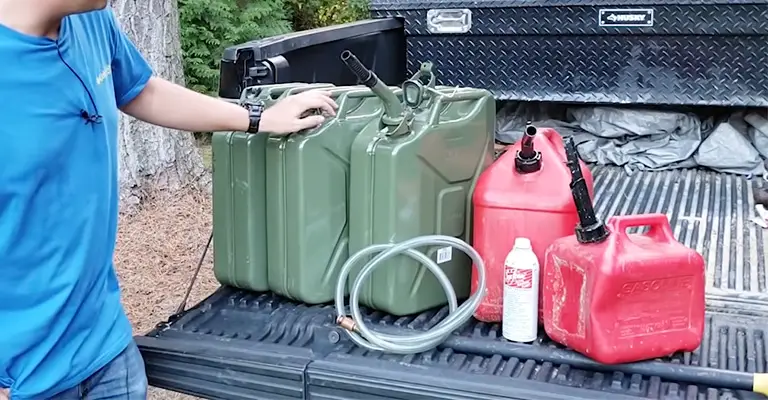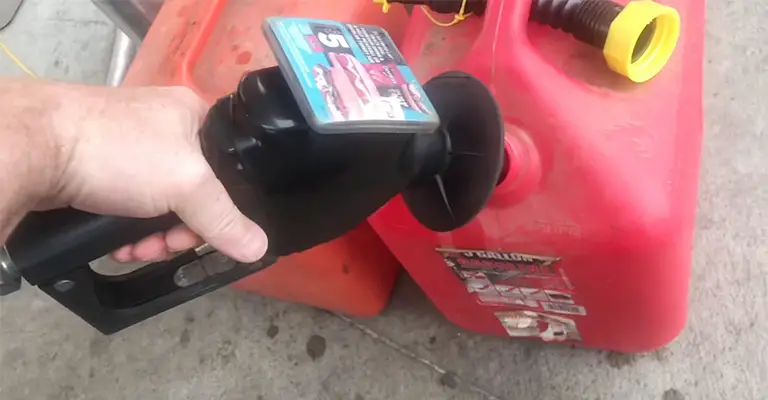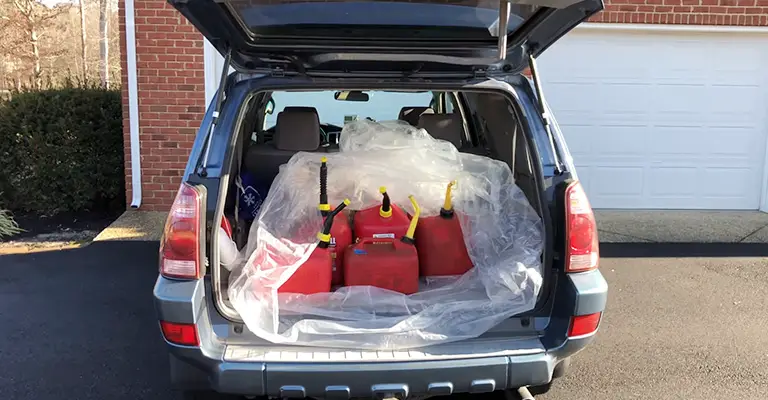Do you enjoy spending time outside in your yard, tending to your lawn and garden? Or maybe you like to be prepared for emergencies and always have a few extra gallons of gas on hand, just in case.
Either way, if you’ve ever wondered whether you can fill a gas can at a gas station, you’re not alone.
It’s a question that many people have, and for a good reason: gas stations are typically designed to fuel up vehicles, not smaller containers. So, can I fill a gas can at a gas station?
Yes, you can fill a gas can at a gas station, but it’s essential to know the rules and safety precautions before doing so.
While gas pumps are primarily designed to fill up vehicles, many gas stations also allow customers to fill up gas cans.
However, it’s important to note that there are some legal and safety considerations to keep in mind when filling up a gas can.
For example, some states have laws governing gasoline transportation, and certain containers are better suited for storing gasoline than others.
Additionally, there are safety guidelines to follow to avoid spills, fires, and other hazards. In this article, we’ll explore the ins and outs of filling up gas cans at gas stations and provide you with some tips for doing so safely and legally.
How To Fill A Gas Can At The Gas Station? | Filling Portable Gas Cans Safely

Using portable gasoline cans from a pump should always be done with extreme caution. It is well known that gasoline is highly volatile after it has been refined.
It is capable of catching fire, exploding, and burning rapidly. These simple tips will help us wait to cut the grass or use the power washer:
- Only use approved gasoline containers with proper labels. Red gas cans must be marked with the Underwriters Laboratories (UL) or American Society for Testing and Materials (ASTM) stamp.
- Ensure that you place the filler nozzle on the rim of the filler opening before filling your container to help static electricity dissipate.
- You should fill the container only 95 percent full. When temperatures rise, allow an air space to allow the fuel to expand.
- Don’t use the trigger lock on the nozzle when you’re filling the can; it’s dangerous.
- Before filling up your car, ensure it’s off and extinguish any open flames or cigarettes.
- You should never fill a container inside a truck bed or vehicle.
- Ensure that the can is clean before putting it in the vehicle (or hose it down).
- Keep the can firmly in place in the vehicle so that it doesn’t slide around. Vehicles should not be transported with containers in the passenger compartment.
- It is never a good idea to leave a gas can in your vehicle for an extended period.
- Gasoline fumes should never be breathed. The effects on your health are extremely harmful.
Is It Legal or Safe To Fill Up A Few Gas Cans At A Gas Station And Store Them In Your Garage?

Keeping your business legal and keeping it safe are two very different things. As far as I can tell, it does not seem like a big deal at first.
The theory of storing some gasoline when it is cheap and using it when it becomes more expensive seems to work as long as nothing bad happens.
I just have a side mark to make. Since the US now mixes gasoline with ethanol, the quality of the gasoline is already disintegrating after a few months due to the mix.
The danger of storing gasoline used to discourage me in my early years, as it did for many others around the globe. It was until I worked in an area with gas lines and other flammable materials that I became acquainted with flammable materials.
Having experienced the effects of highly flammable mediums igniting accidentally, I know how quickly disaster can strike. I found these free lessons to be precious.
As a result, I have changed my view regarding the safe handling and storage of highly flammable materials. Because of this, every county, city, and town in the US (and probably everywhere else) has a code that governs fire safety.
As part of this regulation, the maximum amount of flammable liquids (class 1 and 2) and other “fast-burning” or explosive mediums that can be legally kept in a garage, or on a property, without a special permit and license must be included.
A residential property can have a maximum of 50 gallons of waste water per year in Clark County, which is where Las Vegas is located. There are the same regulations for business properties, but they require a license to store more.
As well as the regulations to follow, businesses, in general, are required to use extraordinary storage cabinets. It is prohibited for businesses to use solutions that OSHA does not approve under OSHA regulations.
The rules are enforced, and the system is monitored periodically. In this way, business safety is taken care of. It is the property owner’s or renter’s responsibility to ensure the safety of private property. Unfortunately, it isn’t always safe.
There is no way it is safe outside of an approved specially designed container, with outside vents at a specific height (away from multiple sources to avoid ignition and poisoning) if the room is closed.
However, when neighbors smell fuel (or any strange smell), they will call 912, informing the police or fire department.
In case of a fire on the property or nearby, it is for the sake of safety not to have an insurmountable amount of flammable matter on one surface.
Likewise, home insurance policies have limitations regarding the storage of flammable ‘matter.’ Fuel should not be stored in enclosed rooms because it can be hazardous!
Unless you have a hazmat certification and hazmat license, you can legally transport only 60 gallons of gasoline with a private vehicle. Guidelines set forth by the DOT.
Additionally, the capacity of an approved tank and the fuel tank in a vehicle is limited to 60 gallons of gasoline. Unlike gasoline, diesel has higher limits. But each flammable liquid and material that weighs more than 1000 pounds requires a hazardous material license.
Also, tankers need to be endorsed to carry liquids. It has been reported that many fires have started due to insecure gasoline storage in garages and homes.
Fires caused by this fuel spread more quickly than regular house fires due to their flammability. Many innocent people were killed because of illegal gasoline storage.
Essential Tips On How To Fill A Gas Can

According to the National Institute for Occupational Safety and Health, the gas should never be filled up in cars with carpeted trunks or floors or on a truck bed with a plastic liner.
There will be no grounding of the can because it will not be grounded. When flowing gas enters your gas can, it creates static electricity. The gas dispenser nozzle can spark and ignite the vapor that emanates from the dispenser.
You should remove your gas can from your vehicle and place it about five feet from it while you’re filling it up. An exhaust manifold or catalytic converter that is hot can ignite the gas vapors because the gas vapor is heavier than air.
To discharge static electricity on your body before filling up, your gas can touch the metal in your vehicle. If you want to reduce static electricity, keep the gas nozzle in contact with your gas can and fill slowly.
It is recommended that you fill your can only 95% complete to allow for expansion. Add a fuel stabilizer to the can every time you fill up for longer-lasting fuel.
Whenever you transport gas cans, make sure they are kept in the trunk or truck bed. Keep the trunk slightly open with a bungee cord to prevent heat buildup and expansion in the gas can.
Adding gas to a hot engine is dangerous since the vapors are likely to ignite.
How To Safely Transport Gas Cans?

Be proactive in preventing gas spills in your vehicle. It is important to ensure all vent caps and caps are on correctly and tightened. You should sit the can upright. You should lock gas cans so they can’t move.
Avoid leaving gas cans in your vehicle for an extended period of time. It is important to avoid enclosing the area. Be sure to open the windows to keep the space well-ventilated.
Leaving gas cans inside the trunk or inside the riding area of your vehicle is not a good idea. Gas can not be placed near heat sources, including the sun and sparks.
Avoid breathing gasoline fumes when you are around children and loved ones. It is not a good idea to place a gas can next to someone while they are sitting.
Make sure the cans are as far away from people’s faces as possible. The presence of a gas that can result in an enclosed vehicle should never be allowed to put children at risk.
Final Words
Because gasoline has a volatile nature, specific procedures should be followed when handling and transporting the gas to ensure the safety of nearby people and buildings.
Among the consequences of gasoline are fire, combustion, and illness due to inhalation. Gas is dangerous anywhere, but you can reduce the risk of tragedy by paying attention to potential hazards and taking precautions.






